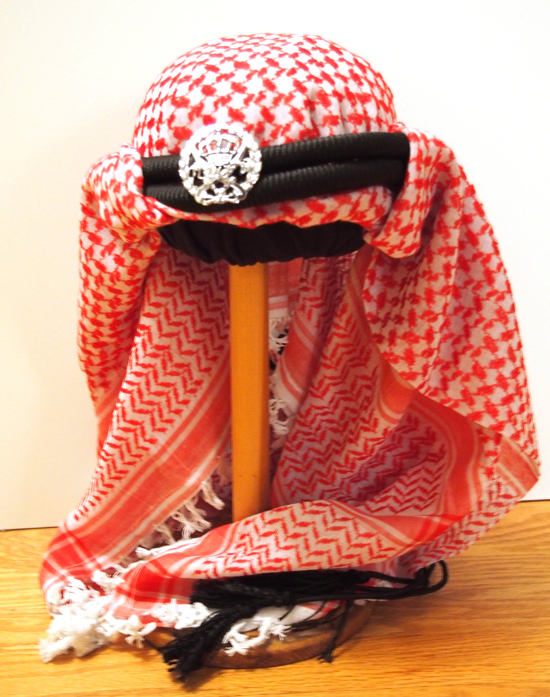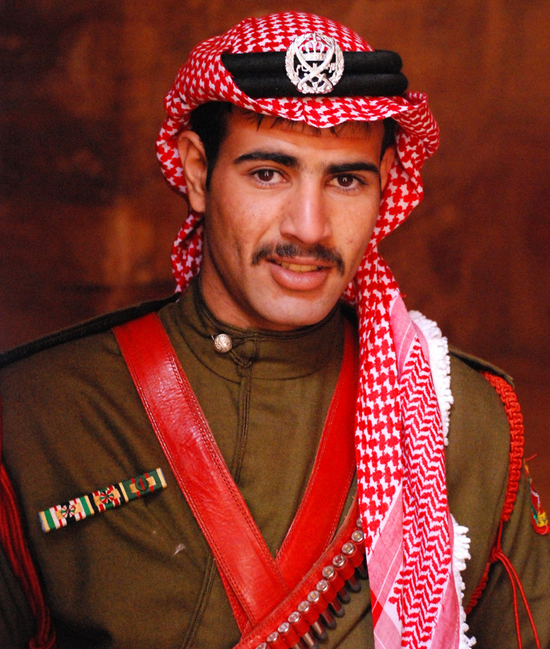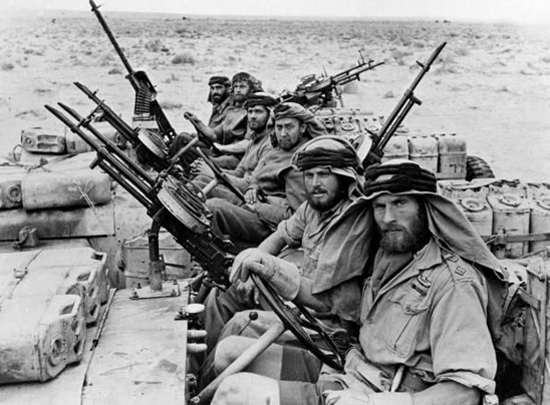The traditional Arab headdress is often – and quite erroneously – called a “turban.” While it may have a shared origin with the Indo-Pakistani turban, including the fact that both are made of cloth, and were originally worn to provide protection from the sun, these are two distinct types of headdress.
The Arabian head scarf is known as the ghutrah, shemagh, but most commonly is referred to as the keffiyeh. It is commonly worn in arid regions; usually is made of cotton and features a distinctive woven check pattern that is believed to have originated in ancient Mesopotamia.
This type of headdress was used by tribesmen since the middle ages, with various colors related to particular tribes.
Following the First World War it was adopted as a standard headdress among Arab soldiers in the British Armed Forces including the Palestine Police Force, The Transjordan Frontier Force, the Sudan Defence Force and the Arab Legion. Most of these Jordanian based units adopted the red-and-white pattern keffiyeh, which is the style that is still used by military unites of the Jordanian Armed Forces.
The keffiyeh became the symbol of Palestine nationalism during the 1936-1939 Arab Revolt, and gained prominence with the Palestinian resistance movement. The traditional Palestinian colors of black and white were worn by such notables as Yasser Arafat, but also associated with Fatah. The red and white colors were also adopted by Palestinian Marxists, but also used today by Hamas. This color symbolism of the scarves is by no means universally accepted by all Palestinians or Arabs – and it should be noted that most modern keffiyeh are actually imported from China. As of 2008 only one Palestinian maker remains in business!
This most Arab of headdress has been used through the years by Westerners as well. British Colonel T.E. Lawrence – “Lawrence of Arabia” – remains the best- known Western wearer of the keffiyeh, which he donned during the 1916-1918 Arab Revolt against the Ottoman Empire in World War I.

Colonel Lawrence (third from the right) with King Faisal I of Iraq (Faisal bin Hussein bin Ali al-Hashemi) during the Paris Peace Conference of 1919
During World War II the keffiyeh – known by the British as the shemaghs – was used by the Long Range Desert Group and the Special Air Service as an alternative headdress to the sun helmet.
Australian solders used the shemagh since the Vietnam War, and various coalition forces have relied on it in Iraq and Afghanistan. The U.S. military has adopted an olive drab version with black stitching – a reversal of policy, which saw the headdress banned during the Gulf War of 1991.
It should also be added that only the actual scarf part of the headdress is the keffiyeh, as the bands or rope that keep the keffiyeh in pace are known as the agal – or iqal, egal or igal.
Peter Suciu




Is the square or rectangular iqal that keeps the keffiyeh in place outdated. I noticed that the earlier Saudi monarchs up to King Faisal wore this iqal. There is a precipitous decline in the use of this type of iqal among the arab monarchs and the general arab population. The circular iqal has replaced the rectangular type that was widely recognizable in the attire of Lawrence of Arabia in the West. Was this merely a fashion and generational shift from the old ways of doing things?
First off I love these keffiyeh scarfs. I am not of middle eastern ancestry but i love them and also respect why they are used. I have a friend who loves them and he is a british Pakistani.
please Check out our group!
https://www.facebook.com/groups/407776856072551/
and please Join US!!!
Pingback: How to Wear A Shemagh: From Tactical to Tacticool Appearance